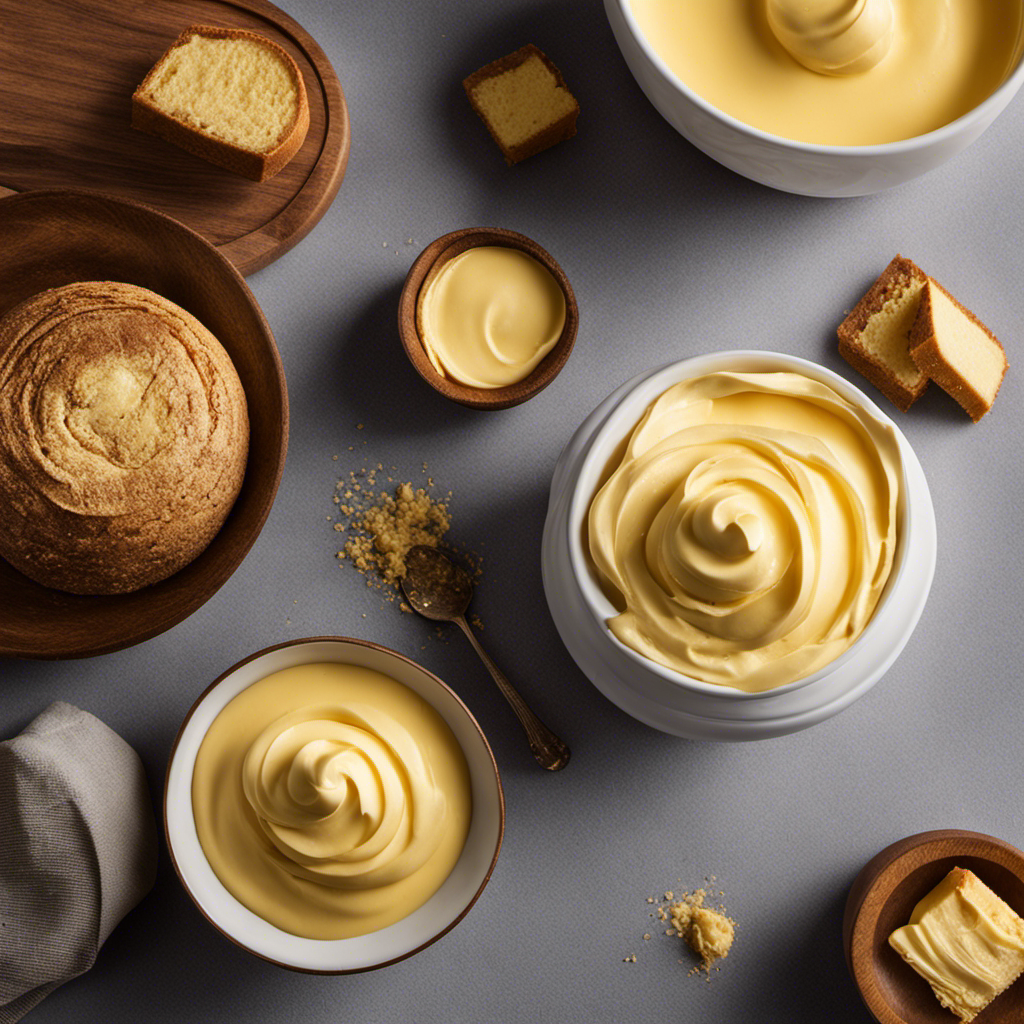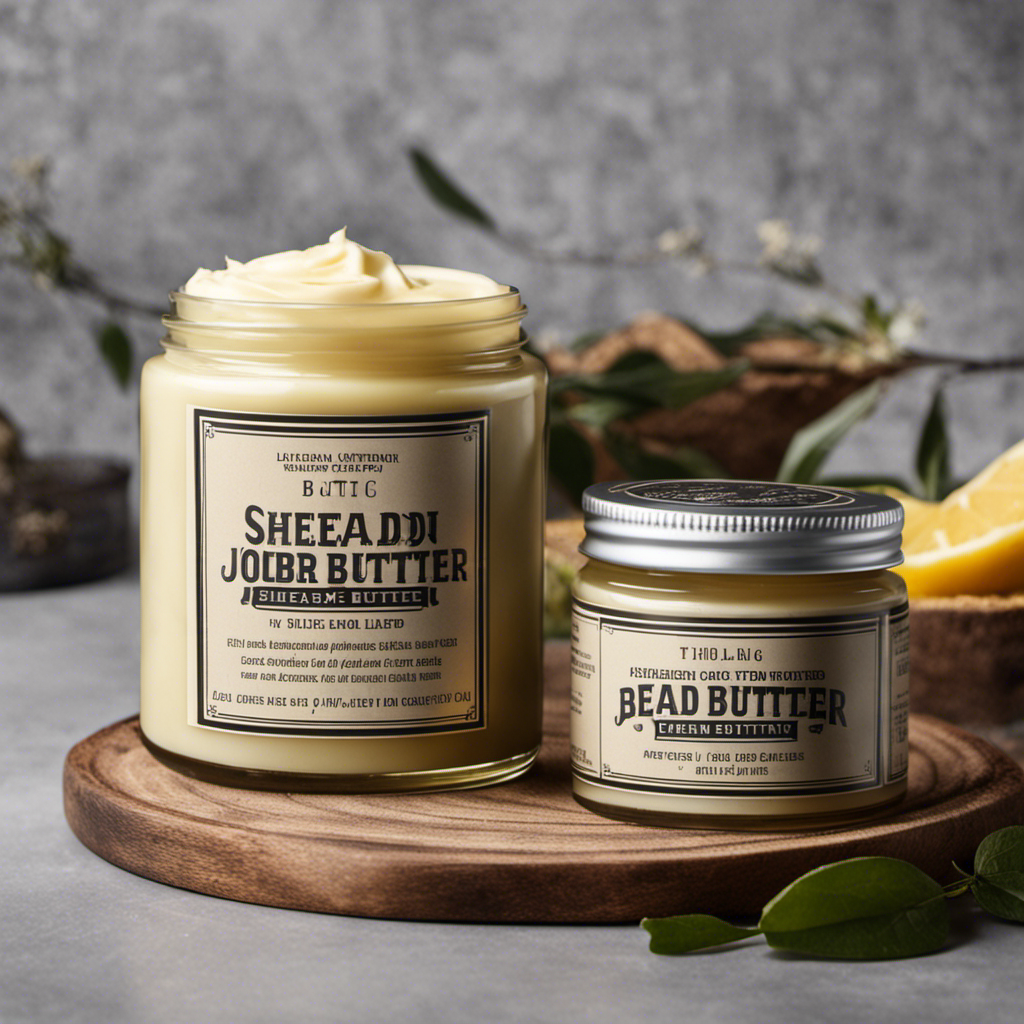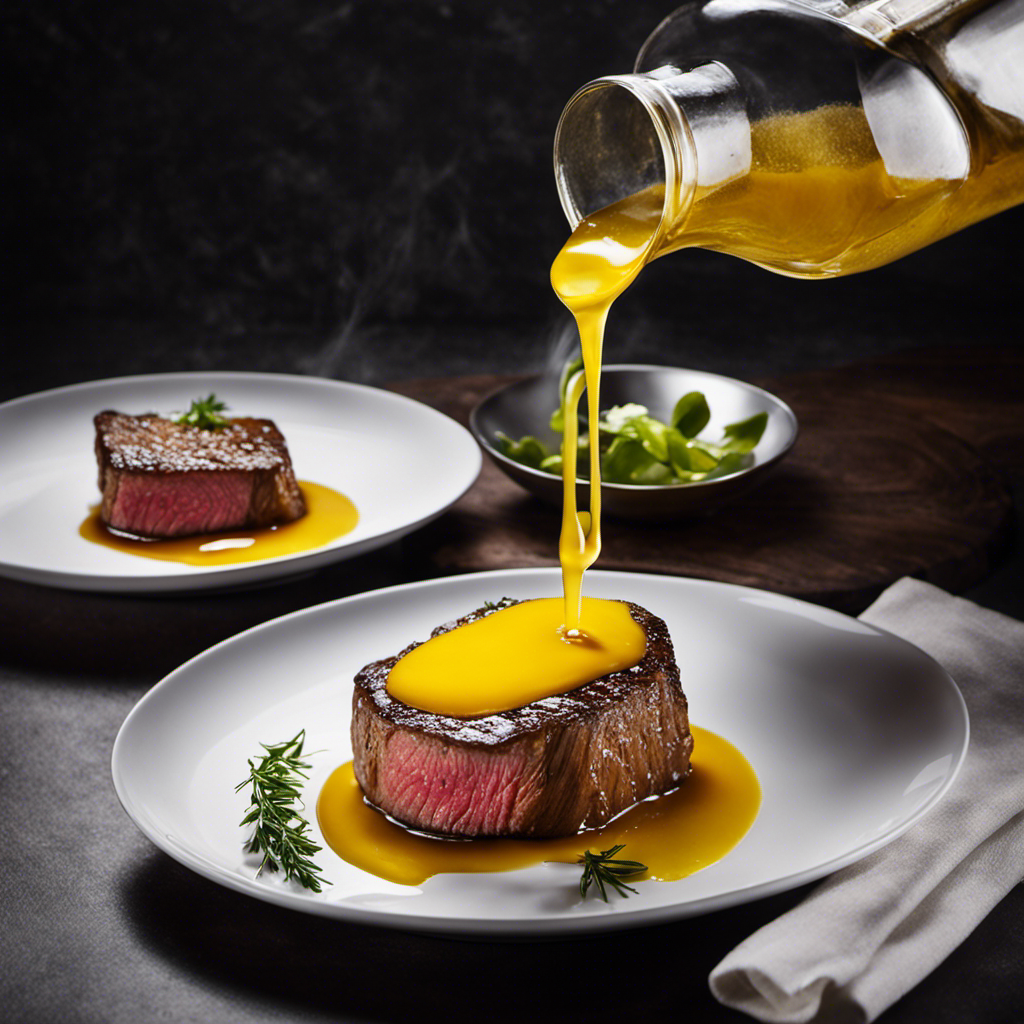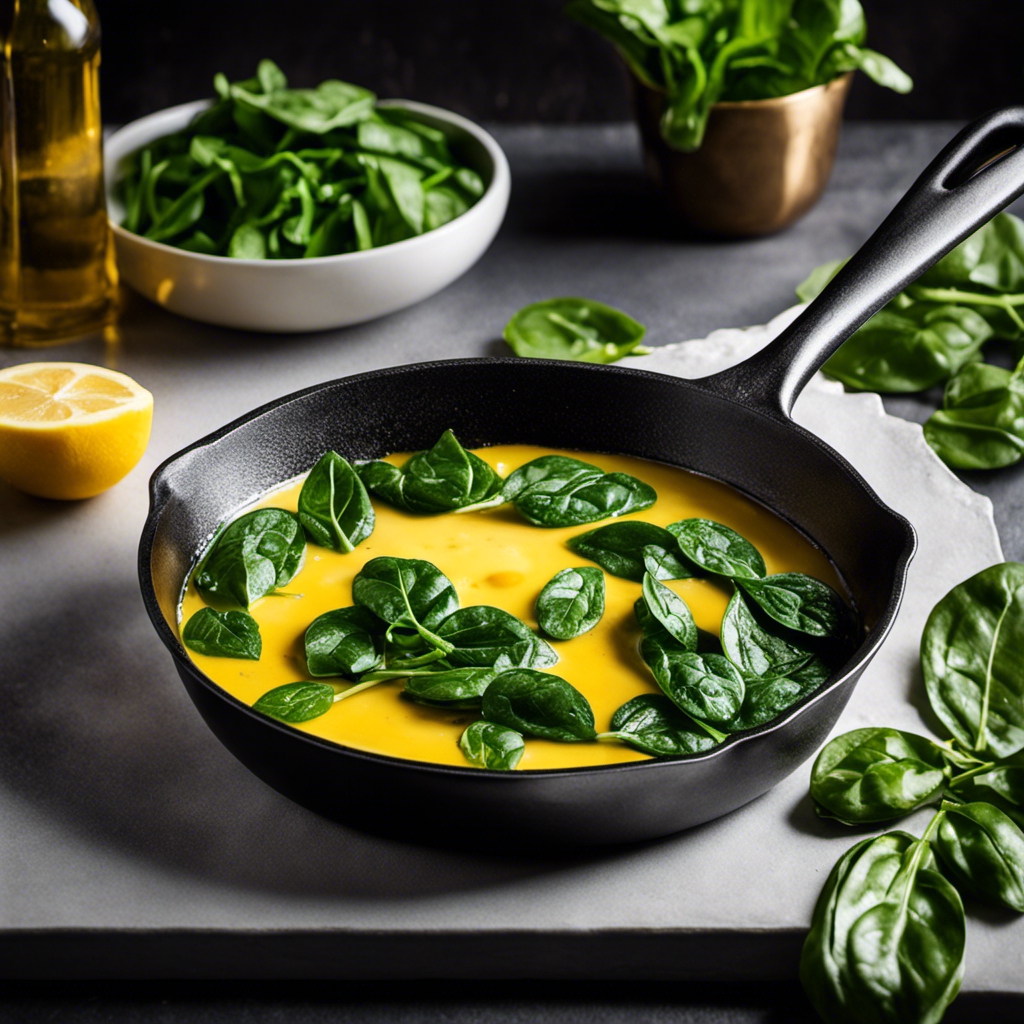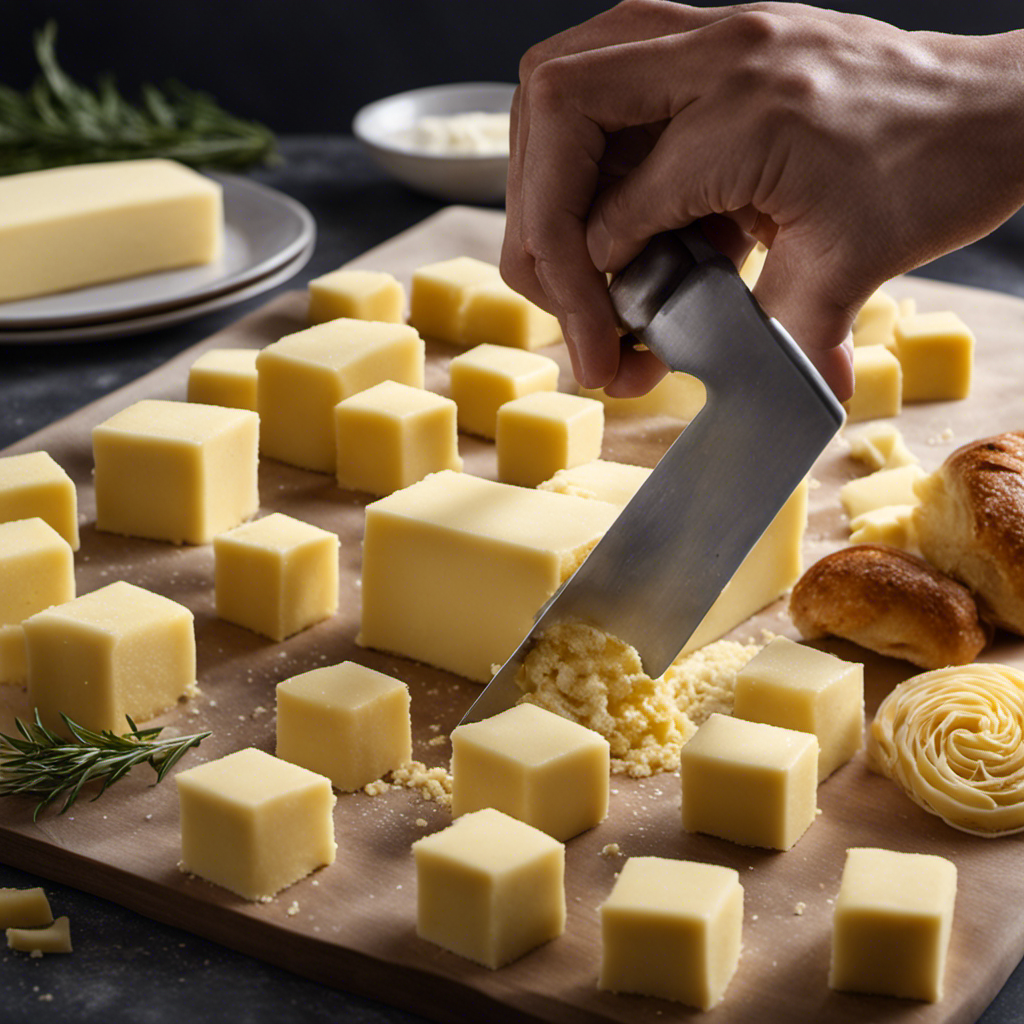As a baking enthusiast, I have always been fascinated by the wide array of ingredients available. Lately, one ingredient that has truly piqued my curiosity is butter-flavored shortening.
What exactly is this magical substance that promises the rich taste of butter in my baked goods? In this article, we’ll delve into the origins, key ingredients, and the process behind making butter-flavored shortening.
Plus, we’ll explore its benefits, various uses in baking, and even compare it to butter and margarine. Get ready to elevate your baking game with this versatile ingredient!
Key Takeaways
- Butter-flavored shortening is a popular substitute for real butter in baking, as it provides a convenient and cost-effective way to achieve a buttery taste and texture.
- Butter-flavored shortening is made from hydrogenated vegetable oils, which contain lower levels of saturated fat compared to butter. Reduced or zero trans fat options are also available.
- The manufacturing process involves blending selected oils and subjecting them to hydrogenation, resulting in a solid fat that resembles butter in texture and consistency. Flavoring agents, such as diacetyl, are added to enhance the taste.
- Using butter-flavored shortening in baking offers advantages such as enhanced flavor, improved texture, extended shelf life, and easy measurement and mixing. It is a versatile ingredient that can be used in a wide variety of recipes.
The Origin of Butter Flavoured Shortening
The origin of butter flavored shortening dates back to the early 20th century. It was created as a substitute for butter, which was expensive and difficult to preserve. Shortening, made from vegetable oils, became popular as a cheaper and more accessible alternative.
However, consumers desired the rich and creamy taste of butter in their baked goods. As a result, food scientists developed butter flavored shortening by adding artificial butter flavorings and enhancers to the vegetable oil base. This innovation allowed bakers to achieve the desired buttery taste and texture in their recipes, without the cost and limitations of using real butter.
Today, butter flavored shortening continues to be a popular choice for baking and cooking due to its convenience, versatility, and ability to deliver a rich buttery flavor.
Key Ingredients in Butter Flavoured Shortening
When it comes to baking, the choice between butter and shortening can greatly impact the texture and flavor of your baked goods.
Butter is made from churning cream, while shortening is typically made from hydrogenated vegetable oils.
The process of making butter involves separating the fat from the liquid, while shortening is produced by adding hydrogen atoms to the oil molecules to make them solid at room temperature.
Butter Vs. Shortening
Butter flavored shortening is a popular alternative to butter for baking. When comparing butter and shortening, there are several nutritional differences to consider:
-
Saturated Fat: Butter contains higher levels of saturated fat compared to shortening, which can contribute to an increased risk of heart disease.
-
Trans Fat: Shortening may contain trans fat, which is known to raise bad cholesterol levels. However, many butter flavored shortenings now have reduced or zero trans fat options available.
-
Cholesterol: Butter contains cholesterol, while shortening is cholesterol-free.
-
Calorie Content: Shortening generally has fewer calories than butter, making it a lower-calorie option for those watching their waistlines.
It’s important to note that while butter flavored shortening provides a convenient alternative for baking, it may not offer the same flavor as real butter. Understanding the nutritional differences can help you make an informed choice when deciding between butter substitutes.
How Is It Made?
To make it, you’ll need a combination of oils, such as palm or soybean oil, and a hydrogenation or partial hydrogenation process to solidify the oil.
The production process of butter flavored shortening involves carefully blending the selected oils and subjecting them to hydrogenation or partial hydrogenation. This process alters the chemical structure of the oils, resulting in a solid fat that resembles butter in texture and consistency.
Flavoring agents are then added to enhance the taste, giving it that distinct buttery flavor. These flavoring agents can vary but often include diacetyl, which provides a rich and creamy butter taste. Other ingredients used may include natural or artificial flavors, salt, and colorings to achieve the desired buttery flavor and appearance.
The combination of oils, hydrogenation process, and flavoring agents work together to create the delicious and versatile butter flavored shortening that is loved by many in baking and cooking.
How Butter Flavoured Shortening Is Made
One popular way of making butter flavored shortening is by blending vegetable oil with artificial butter flavoring. This process involves carefully combining the ingredients to create a smooth and creamy consistency that resembles real butter.
The advantages of using butter flavored shortening in baking are numerous:
-
Enhanced flavor: The artificial butter flavoring adds a rich, buttery taste to baked goods, making them even more delicious.
-
Improved texture: Butter flavored shortening helps create a light and fluffy texture in cakes, cookies, and pastries.
-
Extended shelf life: Unlike real butter, which can spoil quickly, butter flavored shortening has a longer shelf life, ensuring your baked goods stay fresh for longer.
-
Easy to work with: Butter flavored shortening is easier to measure and mix compared to traditional butter, making it a convenient choice for baking.
Using butter flavored shortening in your recipes can significantly enhance the taste and quality of your baked goods. Now, let’s explore the benefits of using butter flavored shortening in more detail.
Benefits of Using Butter Flavoured Shortening
When it comes to baking, using butter flavoured shortening can greatly enhance the quality and taste of your baked goods. Its unique buttery flavor adds a rich and indulgent element to cookies, cakes, and pastries.
Additionally, butter flavoured shortening is incredibly versatile in recipes, allowing you to use it in a wide variety of baked treats.
Lastly, it serves as a convenient substitution for butter, especially for those who prefer a non-dairy option or want to reduce the saturated fat content in their recipes.
Enhances Baked Goods
You can enhance the taste of your baked goods by using butter-flavored shortening. This versatile ingredient not only provides a rich and buttery flavor but also improves the texture of your treats.
Here are four reasons why butter-flavored shortening is a game-changer for your baking:
- It creates a tender and moist crumb, resulting in a softer and more enjoyable eating experience.
- The buttery taste adds depth and complexity to your recipes, making them more indulgent and satisfying.
- Its high fat content helps to create a flakier crust in pie doughs and pastries, elevating their overall quality.
- Butter-flavored shortening also has a higher melting point than butter, which helps your baked goods retain their shape and structure.
With its ability to enhance texture and flavor, butter-flavored shortening is a must-have ingredient for any baking enthusiast.
Now, let’s explore how this versatile ingredient can be used in a wide range of recipes.
Versatile in Recipes
Butter-flavored shortening can be used in a variety of recipes due to its versatility and ability to enhance both texture and flavor. This ingredient is a wonderful addition to any cook’s arsenal, as it can be used in both sweet and savory dishes.
Its versatility in cooking is unmatched, allowing it to be used in everything from cakes and cookies to pie crusts and biscuits. The flavor enhancing properties of butter-flavored shortening are truly remarkable. It adds a rich, buttery taste to any recipe, making it a great substitute for butter in some instances.
Additionally, it helps to create a tender and moist texture, resulting in delicious and perfectly baked goods. Whether you’re baking a cake or making flaky pastries, butter-flavored shortening is an invaluable ingredient that will elevate your dishes to new heights.
Convenient Substitution for Butter
A convenient substitution for butter can be found in butter-flavored shortening, which offers a rich and buttery taste to enhance your recipes. Here are some benefits of using butter-flavored shortening:
-
Provides a creamy texture: Butter-flavored shortening adds a smooth and creamy texture to your baked goods, making them more enjoyable to eat.
-
Enhances flavor: The buttery taste of this shortening elevates the flavor of your dishes, giving them a delicious and indulgent twist.
-
Increases shelf life: Unlike butter, which can spoil quickly, butter-flavored shortening has a longer shelf life, allowing you to keep your baked goods fresh for longer.
-
Easy to work with: Butter-flavored shortening is easy to measure, mix, and incorporate into your recipes, making it a convenient choice for both novice and experienced bakers.
Different Ways to Use Butter Flavoured Shortening in Baking
There are many ways to incorporate butter-flavoured shortening into your baking recipes. This versatile ingredient can add a rich, buttery flavor to your baked goods without the need for actual butter. Whether you’re making cookies, cakes, or pastries, butter-flavoured shortening can be a great substitute.
Here are some alternative uses for butter flavored shortening:
| Baking | Cooking | Frosting | Pie Crusts |
|---|---|---|---|
| Cookies | Pan frying | Buttercream | Flaky crusts |
| Cakes | Sautéing | Ganache | Tart shells |
| Brownies | Grilling | Cream cheese | Quiche crusts |
| Biscuits | Roasting | Whipped | Pudding crusts |
Not only does butter-flavoured shortening provide a delicious taste, but it also helps create a tender texture in your baked goods. It can be especially useful in recipes where the flavor and consistency of butter are desired but without the risk of burning. So, next time you’re baking, consider using butter-flavoured shortening for a delectable twist.
Now, let’s compare butter-flavoured shortening to butter and margarine.
Comparing Butter Flavoured Shortening to Butter and Margarine
When comparing butter-flavored shortening to butter and margarine, it’s important to consider their differences in taste and texture. Butter-flavored shortening is a popular alternative to butter and margarine in baking due to its unique properties.
Here are some key points to consider:
-
Taste: Butter-flavored shortening provides a rich, buttery taste that is similar to real butter. However, it may have a slightly artificial aftertaste compared to butter.
-
Texture: Butter-flavored shortening has a smooth and creamy texture, making it easy to work with in recipes. It also melts at a higher temperature than butter, which can result in lighter, flakier baked goods.
-
Nutritional Differences: Butter-flavored shortening is typically lower in saturated fat and cholesterol compared to butter. However, it may contain trans fats, which should be consumed in moderation.
Overall, choosing between butter-flavored shortening, butter, and margarine depends on personal preferences and dietary considerations.
Tips for Storing and Using Butter Flavoured Shortening
To store and use butter-flavored shortening properly, make sure to keep it in a cool, dry place and use it within the recommended timeframe.
Storing butter-flavored shortening correctly is crucial to maintain its quality and flavor. A cool and dry place, such as a pantry or cupboard, is ideal for storing this type of shortening. Avoid exposing it to direct sunlight or high temperatures, as it can cause the shortening to lose its texture and taste.
Additionally, it is important to use it within the recommended timeframe, usually indicated on the packaging.
As for recipe ideas, butter-flavored shortening can be used in various baked goods such as cookies, cakes, and pie crusts. Its rich and buttery flavor adds a delicious touch to these treats.
Frequently Asked Questions
Can Butter Flavored Shortening Be Used as a Substitute for Butter in All Recipes?
Yes, butter flavored shortening can be used as a substitute for butter in most recipes. It offers a similar flavor but has a different texture. However, for certain recipes that rely on the unique properties of butter, it may not be the best substitution option.
Is Butter Flavored Shortening Suitable for Individuals With Dairy Allergies or Lactose Intolerance?
Butter flavored shortening offers a dairy-free alternative for those with allergies or lactose intolerance. Its benefits include a similar taste and texture to butter, making it a versatile option in recipes.
What Is the Shelf Life and Storage Requirements for Butter Flavored Shortening?
The shelf life of butter flavored shortening can vary depending on the brand and storage conditions. It is typically recommended to store it in a cool, dry place away from direct sunlight to maintain its quality and extend its shelf life.
Can Butter Flavored Shortening Be Used for Frying or Sautéing?
Butter flavored shortening is not ideal for frying or sautéing. There are better alternatives for these cooking methods. However, it can be used in baking and as a substitute for butter in certain recipes.
Are There Any Health Concerns Associated With Consuming Butter Flavored Shortening?
There are health concerns associated with consuming butter flavored shortening. It is high in trans fats, which can raise bad cholesterol levels and increase the risk of heart disease. Healthier alternatives include using oils like olive or coconut.
Conclusion
In conclusion, butter-flavored shortening is a versatile and delicious ingredient. It adds a rich and buttery taste to baked goods. It is made using a combination of oils and flavors to replicate the taste of butter.
With its ability to withstand high temperatures, it is perfect for baking. It creates a tender and flaky texture. Whether you’re making cookies, cakes, or pastries, butter-flavored shortening is a must-have in your pantry.
Its creamy and indulgent flavor will transport you to buttery heaven with every bite.
